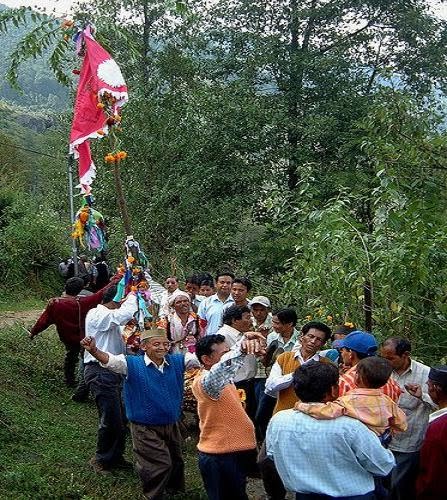 |
| Villagers taking rest on their way down the valley |
The Valley of Johar was inhabited by the Shauka people from the prehistoric times. The Shauka people living in the Johar Valley are also known as Johari or Johari Shauka. They belong to the larger Uttarakhand Bhotiya community, an ethno-linguistic group, and one of the few of Uttarakhand tribes that shows a rich cultural heritage and adhere to the caste system.
The famous legendary love story of Rajuli - Malushahi relates to Rajuli, the daughter of Sunpati Shauka (Local lord/king of Johar) and Malushahi, the scion of one of the branches of Katyuri Kings based in Bairath near Bageshwar. The famous explorers, Pundit Nain Singh Rawat (C.I.E.) and Rai Bahadur Kishan Singh Rawat belong to the Shauka community.
Religion
Shaukas are the followers of Hinduism, and rely on the Hindu Brahmins to conduct their religious ceremonies. Among many local deities, their main deity is Goddess Nanda Devi (Shakti) and their main temples are located in Martoli and Milam.
A number of fairs and festivals take place in and around Munsyari during the months of August and September. Shaukas celebrate the festival of Nanda Ashtami (in honour of the goddess 'Nanda Devi’) in mid-September with great devotion and fanfare.
Culture and Lifestyle
Shaukas were legendary traders of the Kumaon Himalayas and had long Trans-Himalayan trade partnerships with the nomadic Tibetan Khampas and Dokpas, which were formed and nurtured over generations, until China invaded Tibet and the subsequent Sino-Indian War in 1962 caused the closure of this historic trade between India and Tibet.
Traditionally, the Shaukas lived a semi-nomadic life, travelling with their large flocks of pack goats, sheeps and ponies from the trade posts of Gyanima and Gangtok in Tibet, across the innumerable ridges and valleys of Kumaon into the Gangetic plains. The annual migrations of their huge caravans took place along the established trade routes crossing the difficult mountain passes in the Central Himalayas.
 |
| Shauka men dancing during Nanda Ashtami |
Shaukas have a unique and rich culture, but it shows few similarities with the other communities of this region. They belong to the Kshatriya (Rajput) Varna and strictly follow the Hindu caste system. The society of Shaukas is patriarchal and divided into many sub-castes or sub-groups, known as 'Garkha'. The customs and laws of the society (e.g. marriage, family, succession, property, etc.) are same as in any other Hindu society. Some cultural and religious aspects of the Shauka society have influences of the Kumaoni and Tibetan people.
Shaukas are progressive and outward bound people, still following their traditional culture and values. After the closure of the border trade, the Shauka community struggled to survive and to find a place in the new order of life. Today, the ambitious and hard working people of this small hill tribe are leading in all fields (e.g. mountaineering, engineering, medicine, academics, administration, etc.) in India and Abroad!
" चे च्यवा! "

